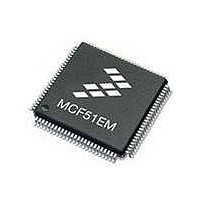MCF51EM256CLL Freescale Semiconductor, MCF51EM256CLL Datasheet - Page 389

MCF51EM256CLL
Manufacturer Part Number
MCF51EM256CLL
Description
IC MCU 32BIT 256KB FLASH 100LQFP
Manufacturer
Freescale Semiconductor
Series
MCF51EMr
Datasheets
1.MCF51EM128CLL.pdf
(2 pages)
2.MCF51EM128CLL.pdf
(54 pages)
3.MCF51EM128CLL.pdf
(636 pages)
Specifications of MCF51EM256CLL
Core Processor
Coldfire V1
Core Size
32-Bit
Speed
50MHz
Connectivity
I²C, SCI, SPI
Peripherals
LCD, LVD, PWM, WDT
Number Of I /o
63
Program Memory Size
256KB (256K x 8)
Program Memory Type
FLASH
Ram Size
16K x 8
Voltage - Supply (vcc/vdd)
1.8 V ~ 3.6 V
Data Converters
A/D 16x12b
Oscillator Type
External
Operating Temperature
-40°C ~ 85°C
Package / Case
100-LQFP
Processor Series
MCF51EM
Core
ColdFire V1
Data Bus Width
32 bit
Data Ram Size
16 KB
Interface Type
RS-232, LIN
Maximum Clock Frequency
50 MHz
Number Of Timers
3
Operating Supply Voltage
1.8 V to 3.6 V
Maximum Operating Temperature
+ 85 C
Mounting Style
SMD/SMT
3rd Party Development Tools
JLINK-CF-BDM26, EWCF
Development Tools By Supplier
DEMOEM
Minimum Operating Temperature
- 40 C
Lead Free Status / RoHS Status
Lead free / RoHS Compliant
Eeprom Size
-
Lead Free Status / Rohs Status
Lead free / RoHS Compliant
Available stocks
Company
Part Number
Manufacturer
Quantity
Price
Company:
Part Number:
MCF51EM256CLL
Manufacturer:
FREESCALE
Quantity:
110
Company:
Part Number:
MCF51EM256CLL
Manufacturer:
Freescale Semiconductor
Quantity:
10 000
- Current page: 389 of 636
- Download datasheet (11Mb)
Independent Robust Real Time Clock (IRTC)
A countdown timer with minute resolution is also provided for time keeping applications. This counter can
be enabled or disabled separately. An interrupt is generated at the expiry of the counter. IRTC module also
provides seven sampling timer interrupts apart from normal interrupts for alarm and countdown timeout.
A frequency compensation module is integrated into the IRTC to correct any error in 1 Hz clock due to
variations in the 32 kHz clock caused by crystal inaccuracy, board variations or change in temperature. The
compensation value for both crystal and temperature variation is set by software and correction is done in
hardware.
The registers in the IRTC are programmable via the IPS bus. A protection mechanism is built-in the IRTC
to protect against spurious writes into the IRTC by any run-away code. The protection mechanism requires
the CPU to write a specific sequence of codes to the IRTC_CTRL[1:0] bits in the control register that
allows write access to the registers. On completing the update of registers the CPU writes any value to
IRTC_CTRL[1:0] bits to enable the write protection. After unlocking the registers, the CPU has a window
of two seconds for updating the register space. On power on reset a window of 15 seconds is allowed for
the CPU to configure the IRTC after which the registers are locked. Any further updates would require the
CPU to unlock the registers.
The IRTC battery supply maintains normal RTC functionality when the CPU power is removed. The
battery supply allows IRTC to keep functioning in case CPU is completely turned off. Reset to the IRTC
block is generated only when both battery supply and CPU power are removed and either is powered up.
The reset generation and switching of power is done external to the IRTC by an analog switch/regulator.
The IRTC is also equipped with a RAM that will be powered by the battery supply in the event of main
supply being switched off. The size of this memory is 32 bytes. MCU can use this RAM to store any data
it wants to retain in case the MCU power is switched off. This RAM will loose all its contents when both
MCU and battery power have been removed.
IRTC can detect any intrusion via its tamper detection mechanism that will get enabled automatically after
the calibration of IRTC is complete. For this purpose, a pin has been provided and high level input on this
pin indicates a tamper which will get stored in the IRTC registers. Removal of battery after calibration will
also be indicated as a tamper. Any tamper detected will cause an interrupt to the CPU. IRTC can also store
the time and date stamp of the latest tamper event recorded. Tamper detection and its interrupt are enabled
on reset.
IRTC has a 32-bit up-counter register that keeps incrementing on writes and read to this register returns
the latest count value. This register will be of use in metering kind of applications where this register can
be used to store the energy consumed over a period of time.
Figure 17-1
shows the block diagram for IRTC.
17.5
IRTC Programming Model
The IRTC contains twenty four 16-bit aligned registers and standby RAM. The table below summarized
the registers and their address with access type. Both the registers and the standby RAM can be accessed
via 8-bit and 16-bit read/write cycles.
MCF51EM256 Series ColdFire Integrated Microcontroller Reference Manual, Rev. 8
Freescale Semiconductor
17-5
Related parts for MCF51EM256CLL
Image
Part Number
Description
Manufacturer
Datasheet
Request
R

Part Number:
Description:
BOARD DEMO HARDWARE ONLY
Manufacturer:
Freescale Semiconductor
Datasheet:

Part Number:
Description:
IC MCU 32BIT 128KB FLASH 100LQFP
Manufacturer:
Freescale Semiconductor
Datasheet:

Part Number:
Description:
IC MCU 32BIT 128KB FLASH 80LQFP
Manufacturer:
Freescale Semiconductor
Datasheet:

Part Number:
Description:
IC MCU 32BIT 256KB FLASH 80LQFP
Manufacturer:
Freescale Semiconductor
Datasheet:
Part Number:
Description:
Manufacturer:
Freescale Semiconductor, Inc
Datasheet:
Part Number:
Description:
Manufacturer:
Freescale Semiconductor, Inc
Datasheet:
Part Number:
Description:
Manufacturer:
Freescale Semiconductor, Inc
Datasheet:
Part Number:
Description:
Manufacturer:
Freescale Semiconductor, Inc
Datasheet:
Part Number:
Description:
Manufacturer:
Freescale Semiconductor, Inc
Datasheet:
Part Number:
Description:
Manufacturer:
Freescale Semiconductor, Inc
Datasheet:
Part Number:
Description:
Manufacturer:
Freescale Semiconductor, Inc
Datasheet:
Part Number:
Description:
Manufacturer:
Freescale Semiconductor, Inc
Datasheet:
Part Number:
Description:
Manufacturer:
Freescale Semiconductor, Inc
Datasheet:
Part Number:
Description:
Manufacturer:
Freescale Semiconductor, Inc
Datasheet:











